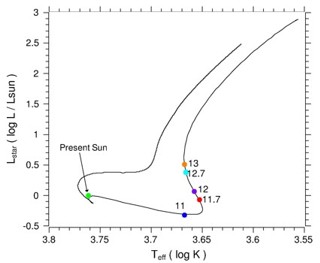Research Areas
CENTRA's Solar and Stellar Physics Group is currently developing work in the following areas:
SEI (Sun - Earth Interaction)
The role of the Sun's variability in the Earth climate and the Earth's surrounding space is a very important subject nowadays. Therefore we are developing work that might allow us to understand the origins of solar variability and perhaps make predictions about solar activity. This project has currently two fronts of action. In the first we use the standard solar model to investigate and recreate past solar activy and we try to understand the structural solar dynamics that might account for the variability observed. The second front is dedicated to solar dynamo models and how their different ingredients contribute to the observed solar activity levels. The role of meridional circulation, rotation and other physical phenomena is investigated using 1D, 2D and 3D solar dynamos models.
Part of this work is done in colaboration with the University of Montreal, Canada, and the Indian Institute for Science Education and Research - Kolkata, India.

Fig.1: Represented in white squares are the observed values and in black circles with
gray error bars, the predicted values for the smoothed anual average amplitude. Our model predicts that solar cycle 24 will have a maximum of about 84 sunspots and should peak around June 2013. For more details please consult Passos 2011, ApJ in our publications section.
Dark Stars (Using Stars as Dark Matter Probes)
The goal of this project is to present an alternative and
complementary approach to the theoretical work that is done in Cosmology and Particle Physics, i.e., to use stars as cosmological tools to probe the
nature of dark matter particles.
This is done by means of
developing a stellar evolution code to study the impact of dark matter
particles on the evolution of stars, namely the low-mass stars. The annihilation of DM
in the core of the star provides and alternative source of energy that leads to
evolution scenarios quite different from the classical evolution of stars. In extreme cases, stars become fully
convective and stay indefinitely in the same position in the HR diagram (see
Figure 2).
 |
Fig.2: Stationary states in the HR diagram of 1 solar mass stars for different DM halo densities, indicated in the labels at
the side of each point, in units of log (GeV cm3).
|
These theoretical stellar models will be used to estimate the contents of dark matter
towards the center of our Galaxy (see Figure 3), by using the observational studies
of stellar populations near the galactic center. Furthermore, we will also use the
asteroseismology as a diagnostic tool to infer the impact of dark matter
particles in the interior of stars, namely in its core.
Part of this work is done in colaboration with the University Cambridge, U.K.
Fig.3: Effective temperature of the stars as a function of the DM halo density and the distance to the galactic center. We considerd DM particles with a mass of 100 GeV and different SD scattering cross sections.
Image from Casanellas & Lopes 2008 |
 |